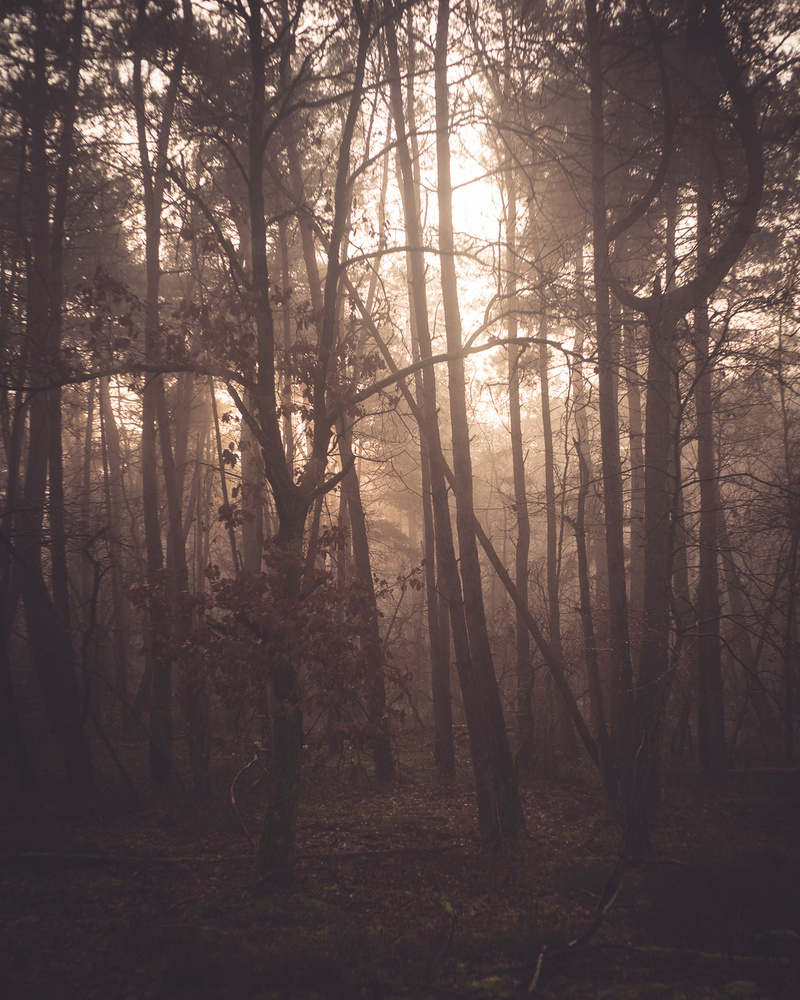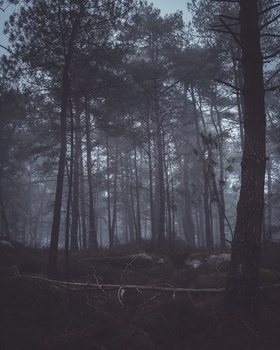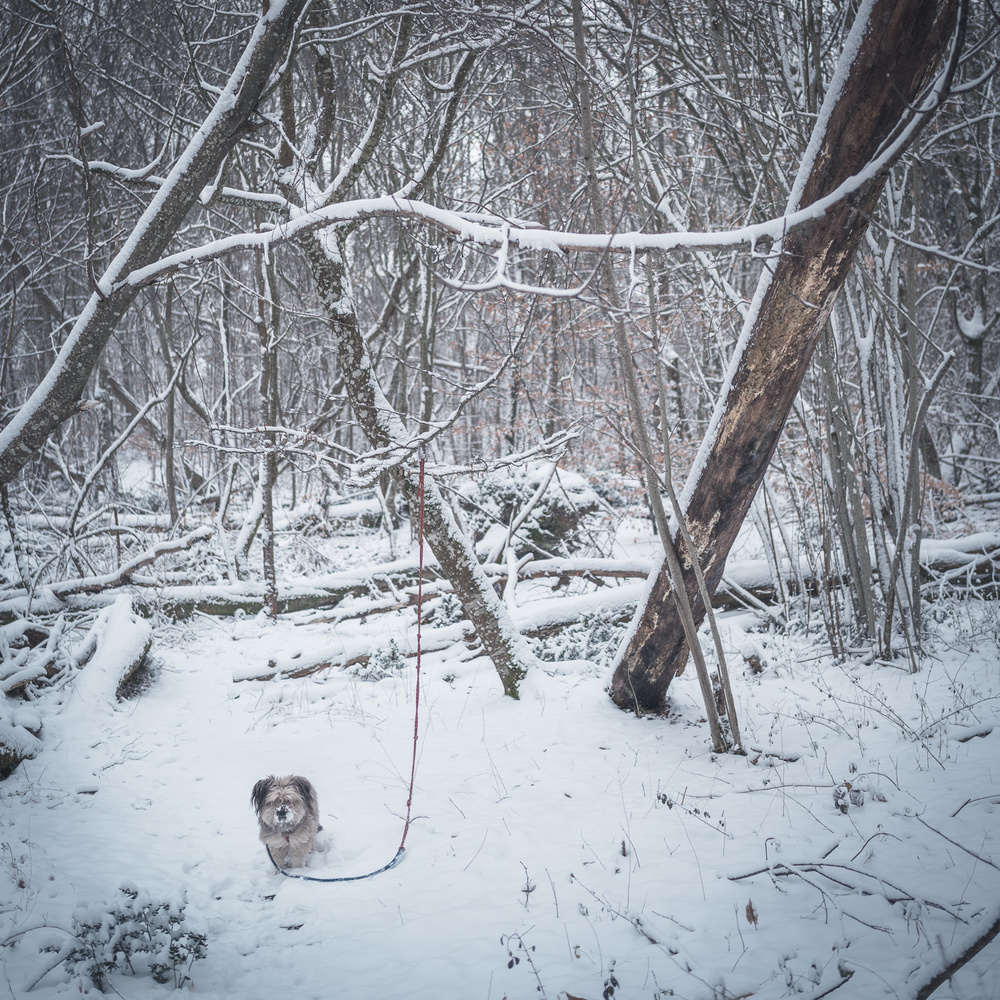Forests might fill us with peace and tranquility, but the chaos of twigs and branches can make them a nightmare to photograph, especially if there’s no single strong feature to focus on. Right now, many of us are photographing close to home so here are 12 tips to help you make the most of your nearest woodland.
I live in the heart of forest that is as varied as it is vast. While walking among the trees fills me with an immense sense of calm, much of what is on my doorstep is far from photogenic — especially in winter. At the best of times, forests can be a mass of chaotic details, all battling with one another for the viewer’s attention, making strong geometric compositions all but impossible.
Most of my photographic journey over the last 18 years has been spent capturing architecture, and trees were often these annoyingly messy elements that I would often go to great lengths to avoid.
Forests are hard. Twigs, branches, and leaves are clutter and confusion, and unless you’re blessed with a forest such as those tracked down by the likes of Mads Peter Iversen, the woods close to you are most likely not that interesting. To a degree, that’s true for me as well given that much of what’s in walking distance of my house is definitely not that exciting photographically.
My daily dog walks have led me to persevere and while I'm no Thomas Heaton, here are some thoughts — particularly with the newer photographer in mind — on how to make the most of the scrappy woodland that might well be a short walk from where your front door.
1. Find the Right Light
Every landscape photographer will tell you this: it’s all about the weather and the light. I often find myself jealous of Hilla and Bernd Becher who chose to shoot their legendary water tower series in the grayest conditions possible. What I’d give for a project that relies on leaden, slate gray skies.
That disheveled patch of trees might look like a nondescript jumble of mayhem on a dull day, but bless it with some golden hour sunshine, and suddenly it becomes transformed. Better yet, snow. Best of all, fog. Photography loves minimalism, and both fog and snow will do a huge amount of tidying up for you, clearing away the clutter and isolating the strongest features.
Fog and snow aside, golden hour is the only time to shoot and in my experience, mornings tend to work better as there’s a greater chance of mist drifting through. You might even get a little bit of haze sitting in the branches, catching and softening the sunlight as it passes through to the forest floor.
2. Don’t Assume that You Need to Shoot Wide
Forests tend to be busy places and a wide-angle lens is an invitation for chaos. It definitely has its place — for example, look up — but unless you have a geometrically strong, dominant subject, you might struggle to create a composition that isn’t chock full of competing elements.
3. Shoot in Portrait Orientation
If your trees are proving too chaotic, in addition to ditching the wide angle lens, try shooting in portrait orientation. This means fewer trees in your frame and also an opportunity to emphasize verticality. In terms of composition, vertical lines typically evokes feelings of calmness and stability, helping you to tap into exactly the feelings that trees are supposed to conjure.

4. Make it Vertical
In general, trees are tall and unless you have a tilt-shift lens in your bag, you’ll find that pointing your camera upwards will cause the trees to lean towards one another. If you’re going to make them lean, go wide and embrace the converging lines as a feature; if they’re just leaning a little bit, I tend to find that my image ends up being a bit indecisive and compositionally weaker as a result. In addition, slightly diagonal lines that lead the viewer's eye towards the top edge of the image — rather than towards the center — tend to weaken your overall composition. If your verticals are collapsing, make them truly diagonal (you might want to use that wide after all), not slightly off-kilter.
As mentioned, vertical lines give us that sense of tranquility, but keeping your camera level to keep the trees straight in your frame can mean including a lot of the forest floor. This tends to be messy and can easily produce an unbalanced composition. For this reason, try shooting with a crop in mind: assume that the bottom fifth or sixth of your image is going to be removed once you edit the images. Of course, this means compromising on image quality but photography is a constant game of compromises and this is one I’m willing to make if it means a better frame. I’ve neither the time nor the money to be shooting 10” plates on a field camera whose lens I can tilt, so this is where I’m happy to cheat.
If your 24-megapixel image ends up being 16 megapixels, just pretend it’s 10 years ago. Unless you plan to print it on the side of a bus, it’s not going to be an issue.
5. Seek Out the Fallen Heroes
Not every tree makes it and the soil close to me is very sandy, meaning that fallen trees are everywhere. One particular patch is like a graveyard, trees tumbling as soon as they get too large, with others then repeating the pattern, stacking up on one another as the decades roll by.
Fallen trees break up the verticality, bringing some horizontals and diagonals to an otherwise relentlessly upright world. Seek them out.
6. Ditch the Rules
Forests are often too chaotic for formal rules of composition and things like the rule of thirds can be useless. If you’re struggling to find bold frames, don’t waste your time: instead, try creating images that are more impressionistic rather than formal. Experiment with images that are full of motion blur or are wildly out of focus.

Taken by my partner, Zofia, who is not an experienced photographer. She took this while setting up her camera ahead of a walk in the snow. It turned out to be far better than anything I came back with that day. Courtesy of Zofia Reych.
7. Be There and Be Square
There’s something about the square format that can bring a sense of order to a chaotic scene and with so many competing elements in a forest, sometimes it’s as simple as cropping out a chunk of them to get something that works.
The canopy of a forest tends to be photographically even more chaotic than the trunks, not to mention that the contrast between the darkness of the trees and the brightness of the sky can be intense and distracting as a result. Try chopping it out and see what happens.
8. Use a Cheap Lens and Be Shallow
With so much contrast and chaos, a density of trees doesn’t always lend itself well to a sharp lens and lots of depth of field. If your bedraggled woodland doesn’t look great because it’s just too much of a tangle, you can soften much of it by using a wide aperture and tone down the contrast by using a low-quality lens.

Faux vintage rather than vintage: taken on the 7artisans 35mm f/1.4. A low contrast lens for a low contrast day.
Vintage lenses offer large apertures that give distinctive swirly, out-of-focus areas towards the corners of the image and loads of cameras have an adapter available that allows you to use M42-mount lenses. Something like a Takumar 35mm f/2 is probably a good place to start.
9. Find Weird Things
Forests and woodlands can be half-forgotten, oft-ignored, in-between zones that collect weirdness, and the random stuff that I find in the forest has become something of an obsession. (The other day, I found an entire kitchen sink.)

These little islands of confusion among the trees can be surreal when photographed in the right light — particularly fog. Embrace the weirdness.
10. Find Space
As a general rule, the denser the forest, the more difficult the photographs, and finding a clearing or simply the edge of the forest so that you have a bit of distance can help you to find a more minimal composition.
11. The Hills Are Alive
Any change in elevation gives you a chance to create a stronger sense of depth in your images and potentially introduce more diagonal lines that lead the eye as a result of repeating patterns or suggestions of geometric shapes.
12. Get a Dog
With so much of forest photography being dependent on conditions, catching the right moment can be a challenge. Getting up early and heading into the trees in the hope that the sun will rise into a clear sky can be a gamble — unless you have a dog and you’re heading there anyway. My Bulgarian rescue dog takes me every day into the forest and my newfound interest in photographing the trees would not have come about without him.
Dog ownership has rocketed during the global pandemic and if you do plan on making an addition to your family, I’d urge you to get a rescue dog. I guarantee warm and tingly feeling for having done a good deed.
Closing Words
Hopefully I've given you a few ideas of how to photograph dense woodlands. If you need an extra reason to head to the forest, it's now proven that trees can boost your immune system as well as improve your mood.
If you've any further suggestions, feel free to post in the comments below. Happy shooting!

















Terrific images. Thanks for the article.
You're welcome! I hope it was useful. 😊
Best how-to I've read in a long time, thank you very much! I've been struggling with forest photos this winter and will definitely keep a couple of these tips in mind the next time I'm out. At least we've got a little snow in the trees now...
Thanks! I struggle with the snow a bit. Sometimes it seems to add more strong contrast, adding to the distractions. I hope you find some good shots. 😊
Forests are indeed hard, and these are great images. And great advice (unusually practical for a photo blog)... except for the golden hour thing. Forests lend themselves so well to gray, foggy, drizzly conditions. Winter in particular with low sun means we can have hours of great photography in the woods beyond the golden hour if the conditions are right. I'd say don't limit yourself to that small window. I think Tom and Mads would agree! ; )
Fog, definitely, as mentioned in the article. But leaden skies and drizzle make it really hard in my experience, unless the forest has some really bold features.
Gray skies and dry weather are boring for sure. But I love a drizzly day in the woods, even without 'good light' or mist. Just took a walk in the Manzanita and Madrone woods near home in a light rain yesterday and had a blast, even if I only got 'filler' shots. You have to focus on details but if you have a woods with lots of smooth wet bark, or moss and fungus etc, you can still get great woodland images. I think the big reason people struggle so much with woodland shots is they tend to bring their normal landscape photo compositional ideas and habits with them, they get stuck looking for big shots, wide angles, amazing light, and miss lots of other opportunities.
Great photos. Love taking photos in the forest.
Thanks! 😊🙏🏻
Great tips! Can't wait to try out. I have been struggling to anything with woods.
Excellent. Good luck!
These are all good ideas and I've used many of them, sometimes accidentally.
"Just pretend it's 10 years ago" is a pearl of wisfom.
Ha! Glad you appreciated it. 😊
I totally like the idea of using portrait mode
Give it a go. 😊
Nice pics and great tips!
Thanks!
Thanks!
Great ones Andy. Not overly edited and keeping the atmosphere.
Thanks! I think I'm right on the edge of overcooking them so that's good to hear. 😊
Some good tips, but I don't agree with the golden hour being the only/best time to shoot in forests. And neither do you, really, as your examples are all way past golden hour (looks like mid-morning in the very first photo). Depending on the location, it can take a few hours after "golden hour" for the sun to clear mountains, rocks, etc, and give you those beautiful beams of light. I guess we could call it "forest golden hour," though.
To give one example, here's a photo I took at 11:30am in December. The light was only on the bridge for about 15 minutes, and while I didn't fully capture it the way I envisioned, and it's no award-winner, it is a reminder to me that "good" light can happen anytime any place in a forest. You just have to be out there looking. And be ready, because it doesn't last long.
#9 is the way to go. Find the jankiest trees you can.
Great article Andy! Original tips to photograph something most of us take for granted. Love the blurry one! 👏
Thanks Mark! 😊🙏🏻